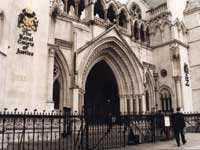
Children who were unlawfully restrained in privately-run child prisons over a 10-year period could pursue compensation claims, according to a high court judge.
The number of potential claimants could reach thousands, experts have warned.
Passing judgement this week on a judicial review case brought by the Children’s Rights Alliance for England (CRAE), Mr Justice Foskett said the government was under no legal obligation to identify potential victims and notify them of their right to seek compensation – as CRAE had argued.
However, he pointed out that victims could come forward themselves.
“It probably requires just one former detainee, looking back at his or her experience in a [secure training centre] and having conducted the necessary preliminary inquiries, to pursue a well-publicised claim and others will be alerted to the potential of pursuing matters,” he said.
The judge said it was highly likely that large numbers of children were unlawfully restrained in privately-run secure training centres (STCs) for at least a decade between 1998 and 2008.
“I do not think that there is any true or realistic alternative to the conclusion that probably up until July 2008 (and possibly, though unlikely, for another two years thereafter) there was widespread unlawful use of restraint within the STC system and many children and young persons were subjected to such restraint,” he wrote in the judgement.
Restraint techniques involved included the controversial, and subsequently banned, nose distraction technique used on 14-year-old Adam Rickwood hours before his suicide in 2004.
Rickwood’s death at Hassockfield STC and the 2004 death, following restraint, of Gareth Myatt, 15, at Rainsbrook STC led to the discovery of information about unlawful restraint.
The judge said statutory agencies had failed to take appropriate action to stop the unlawful treatment, also criticising the Youth Justice Board (YJB) for its “apparent active promotion” of the methods, due to “confused thinking” until 2007.
He said the “fullest explanation” had not yet emerged as to why widespread unlawful restraint went unchecked for so long, and why there were apparently so few complaints from victims.
Mark Scott, a solicitor for CRAE, said he hoped the judgment would encourage children who were subject to unlawful restraints by STC staff to “come forward and seek redress”.
Carolyne Willow, CRAE’s national co-ordinator, said there could be “potentially thousands of former detainees of STCs being entitled to claim compensation for unlawful restraint. The violations went unchecked for at least a decade so the scale of claims could be enormous.”
But she warned victims would need to know they may have a claim. “Without action by the government we firmly believe former detainees will remain ignorant of their entitlement to seek justice. Unlawful restraint was so endemic that children detained at the time would have seen it as normal and legitimate. The professionals around them certainly did,” she said.
Related Articles:
Good practice: How children’s home consigned restraint to history


 Bournemouth, Christchurch and Poole
Bournemouth, Christchurch and Poole  Hampshire County Council
Hampshire County Council  Lincolnshire County Council
Lincolnshire County Council  Norfolk County Council
Norfolk County Council  Northamptonshire Children’s Trust
Northamptonshire Children’s Trust  South Gloucestershire Council
South Gloucestershire Council  Wiltshire Council
Wiltshire Council  Wokingham Borough Council
Wokingham Borough Council  Children and young people with SEND are ‘valued and prioritised’ in Wiltshire, find inspectors
Children and young people with SEND are ‘valued and prioritised’ in Wiltshire, find inspectors  How specialist refugee teams benefit young people and social workers
How specialist refugee teams benefit young people and social workers  Podcast: returning to social work after becoming a first-time parent
Podcast: returning to social work after becoming a first-time parent  Podcast: would you work for an inadequate-rated service?
Podcast: would you work for an inadequate-rated service?  Family help: one local authority’s experience of the model
Family help: one local authority’s experience of the model  Workforce Insights – showcasing a selection of the sector’s top recruiters
Workforce Insights – showcasing a selection of the sector’s top recruiters 

 Facebook
Facebook X
X LinkedIn
LinkedIn Instagram
Instagram
Comments are closed.